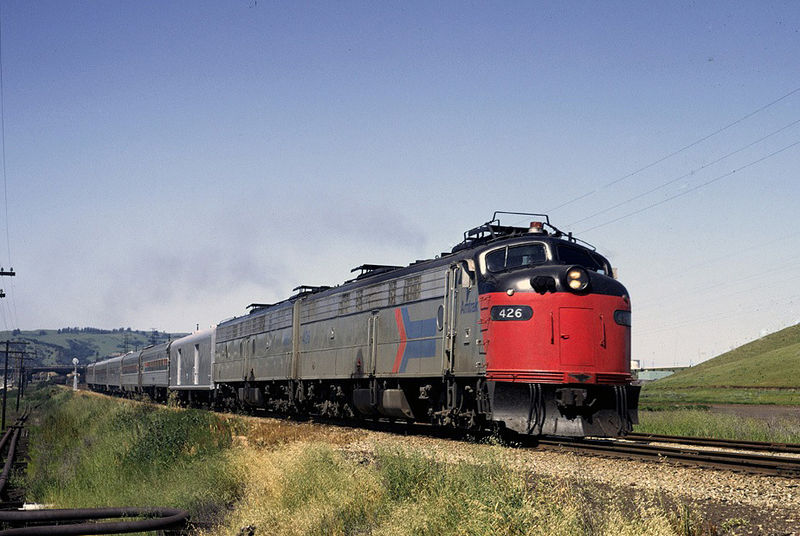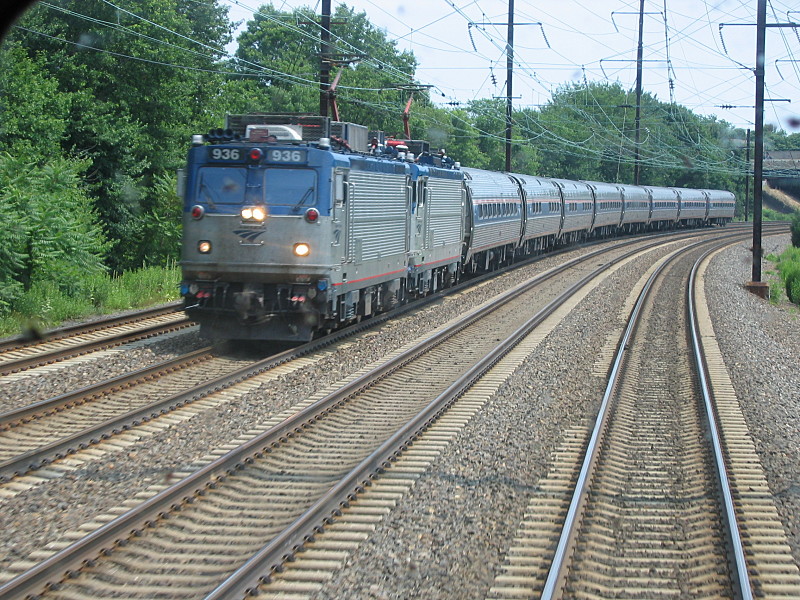1978-1980
New AEM7 hauled trains were a great success for years to come
The middle section of the 1970s had been a time of great change for Amtrak. Out went it's 'Rainbow' formations, consisting of rag tag coaches, and in started coming new coaching stock and new locomotives. This was a time of modernisation and renovation, as Amtrak sought to create the basis for sustainable operations.
In the Mid-West, consolidation continued. The rationalisation of central stations continued, with the closure of LaSalle station. The Rock Island (Chicago, Rock Island & Pacific Railroad) had continued running passenger trains themselves privately, figuring it would be more financially agreeable to do so, but in the end The Rock still fell to bankuptcy. Amtrak took over the remnants of The Rock's passenger services, including the tracks themselves for running the passenger routes on. One of the first things that Amtrak would do would be to utilise the link from the Rock suburban service on to Amtrak's route heading into Union station, resulting in the closure of the LaSalle station. The land was sold to the metropolitan authorities, resulting in the relocation of the Chicago Stock Exchange to LaSalle's former location. The relationship between Chicago and Amtrak had grown over the 1970s, with the introduction of grants from Illinois State to Amtrak (in this respect, legally "Amtrak Illinois", which would own the freehold and maintain most of the infrastructure within the State of Illinois) for the operation and improvement of suburban services within Illinois, which resulted in further purchases of Amtrak's reliable F40PH locomotives from General Motors along with many Superliner coaches for use.
Further improvement works bore fruit when the renovated Chicago Union station reopened, with 8 through tracks now through the former central plaza area that used to lie between the tracks. There would be 4 tracks for suburban services, and 4 tracks for express services through the station, and with the opening and joining of suburban services, it suddenly became easy to travel across Chicago city centre. Now locomotive movements and driver changes would only need doing at the city limits resulting in a lot of time saving. It was a similar picture for Amtrak's express services; travel from Minneapolis & Milwaukee to Indianapolis & Cincinnati.
Switching to the North East Corridor however, and huge changes were occuring. In late 1978, the first new AEM7 locomotives were coming online. The first batch would be dual-electric powered (capable of utilising both 11kV and 25kV @ 60Hz) for immediate service as far as Boston, and running south to Washington DC while the electric supplies were re-engineered to supply 25kV instead. The use of 11kV had been the preferred choice of Amtrak's predecessor "Pennsylvania Railroad", but it was widely viewed now as supplying insufficient power for modern trains. As AEM7 locomotives started hauling services from Boston to New York, the UAC Turboliners were retired from service, becoming unreliable - especially in the face of Amtrak's other trustworthy diesel traction. In combination with the electrification works on the NEC, significant resignalling of the route was conducted at the same time, to allow trains to run faster, as well as more of them (particularly important through New York Penn Station and the approaching tunnels).
And all that, occurred at the same time as the opening (in early 1980, slightly delayed by NEC improvement works) of the New York Rail Link. Amtrak's express services along the NEC would now been divided into 3 routes:
- Washington DC to New York JFK Airport
- Boston South to New York JFK Airport
- Washington DC to Boston South
A further addition was that the services running to/from JFK Airport would be equipped with dedicated baggage cars (in reality refurbished Amfleet coaches with roll-up doors for quick loading) to convey checked-in baggage at Amtrak stations. Pan-Am staff ran what looked like airport check-in desks in Washington DC, Baltimore, Philadelphia, New York, New Haven, Providence & Boston in the end, allowing departing passengers to check in their luggage at their local station and then travel to the airport. At the airport, they could then walk straight through to departures with no further action, with their baggage being transferred to the airport by Amtrak personnel and handed over to Pan-Am staff at JFK station.
Arriving passengers had been a little more difficult to accommodate due to problems with US Customs. In the end, a compromise had been worked out, allowing close integration for arriving passengers. Passengers landing at the JFK Worldport would pass through immigration, and then collect their bags from a special baggage collection hall where Amtrak-bound bags would be sent. They would then pass through US Customs with their bags, and Amtrak would then relieve the passengers of their baggage and convey them to the destination station. This allowed passengers to quickly pass through the airport and board a train swiftly to get to their destination. It was an experimental model, that would prove to be highly successful. "Remote check-ins", as Pan-Am referred to airline check-in at Amtrak stations, soared rapidly in the first year, with significant numbers of passengers from New York, Philadelphia, Newark and New Haven using the facilities, attracted by the integrated operation as well as the modern & comfortable Amtrak trains taking them to & from the airport. Pan-Am ended up treating Amtrak services in effect as Pan-Am flights which happened to be operated by someone else, with baggage & airline passengers destined for an IATA code designated for the station.
Elsewhere. 1979 also saw the initiation of Amtrak California, another Amtrak entity to centralise and take over operations in California in agreement with the State of California (and subsidised by), after Southern Pacific announced their intention to withdraw from passenger operations. Amtrak operated a few trains along the entire Californian coast, and several commuter rail operations, primarily based on San Francisco & Los Angeles. The operation was tactical on many fronts. First amongst these was the aim to integrate operations and compete in the densely populated State of California. Amtrak also had a eye on possibly replicating it's partnership with Pan-Am from San Francisco airport, serving the wider Californian area. San Francisco Airport was already located adjacent to the main line into San Francisco from the south, and therefore had easy connection possibilities into San Francisco 4th & King, San Hose and potentially the Oakland side of the San Francisco Bay.

The San Joaquin, one of the services to be brought into Amtrak California
-------------------------------
Notes: Amtrak investment beginning to show now. AEM7 locomotive power coupled with Amfleet coaches whizzing up and down the NEC, running to destinations further north then New York as electrification comes online (first to New Haven, then to Boston, and finally the branch to Springfield). Expect train times to fall, and passengers to flock to the Amtrak NEC services as a result of the quick journies offered and it's integration with Pan-Am. I couldn't think of any better way to handle international arrivals needing to go through US Customs then that quoted. I did think about domestic arrivals, but at the time Pan-Am is still an international-only carrier right? Also note that the electrification will be 25kV all the way along the NEC - should allow for quicker acceleration then the 11kV that exists OTL Washington DC - New York which isn't as powerful.
On a side note, it's goodbye to the UAC Turbotrains. They've lasted longer they did OTL in this TL, but they're waiting for the scrapper now.
I'm starting to plot out the commuter rail services in Boston at the moment, so a roundup of that will be coming up in the next chapter.

